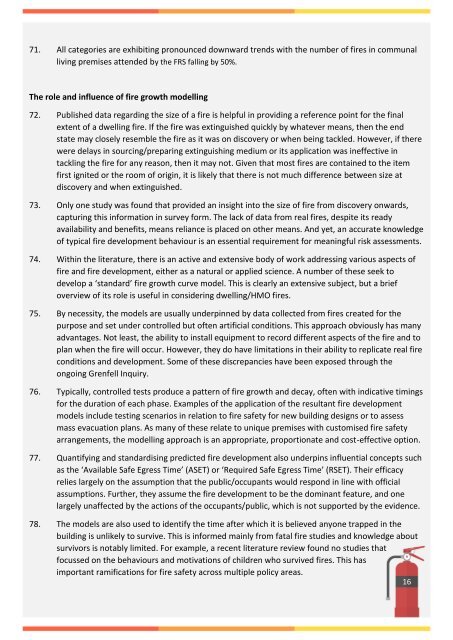An evaluation of the role of fire extinguishers
A report considering the role of a fire extinguisher in human terms identifying the gap between policy assumptions and the evidence from real fires. It considers the implications arising from this and makes a number of recommendations to create an evidence base and enhance current fire safety policies/advice.
A report considering the role of a fire extinguisher in human terms identifying the gap between policy assumptions and the evidence from real fires. It considers the implications arising from this and makes a number of recommendations to create an evidence base and enhance current fire safety policies/advice.
You also want an ePaper? Increase the reach of your titles
YUMPU automatically turns print PDFs into web optimized ePapers that Google loves.
71. All categories are exhibiting pronounced downward trends with <strong>the</strong> number <strong>of</strong> <strong>fire</strong>s in communal<br />
living premises attended by <strong>the</strong> FRS falling by 50%.<br />
The <strong>role</strong> and influence <strong>of</strong> <strong>fire</strong> growth modelling<br />
72. Published data regarding <strong>the</strong> size <strong>of</strong> a <strong>fire</strong> is helpful in providing a reference point for <strong>the</strong> final<br />
extent <strong>of</strong> a dwelling <strong>fire</strong>. If <strong>the</strong> <strong>fire</strong> was extinguished quickly by whatever means, <strong>the</strong>n <strong>the</strong> end<br />
state may closely resemble <strong>the</strong> <strong>fire</strong> as it was on discovery or when being tackled. However, if <strong>the</strong>re<br />
were delays in sourcing/preparing extinguishing medium or its application was ineffective in<br />
tackling <strong>the</strong> <strong>fire</strong> for any reason, <strong>the</strong>n it may not. Given that most <strong>fire</strong>s are contained to <strong>the</strong> item<br />
first ignited or <strong>the</strong> room <strong>of</strong> origin, it is likely that <strong>the</strong>re is not much difference between size at<br />
discovery and when extinguished.<br />
73. Only one study was found that provided an insight into <strong>the</strong> size <strong>of</strong> <strong>fire</strong> from discovery onwards,<br />
capturing this information in survey form. The lack <strong>of</strong> data from real <strong>fire</strong>s, despite its ready<br />
availability and benefits, means reliance is placed on o<strong>the</strong>r means. <strong>An</strong>d yet, an accurate knowledge<br />
<strong>of</strong> typical <strong>fire</strong> development behaviour is an essential requirement for meaningful risk assessments.<br />
74. Within <strong>the</strong> literature, <strong>the</strong>re is an active and extensive body <strong>of</strong> work addressing various aspects <strong>of</strong><br />
<strong>fire</strong> and <strong>fire</strong> development, ei<strong>the</strong>r as a natural or applied science. A number <strong>of</strong> <strong>the</strong>se seek to<br />
develop a ‘standard’ <strong>fire</strong> growth curve model. This is clearly an extensive subject, but a brief<br />
overview <strong>of</strong> its <strong>role</strong> is useful in considering dwelling/HMO <strong>fire</strong>s.<br />
75. By necessity, <strong>the</strong> models are usually underpinned by data collected from <strong>fire</strong>s created for <strong>the</strong><br />
purpose and set under controlled but <strong>of</strong>ten artificial conditions. This approach obviously has many<br />
advantages. Not least, <strong>the</strong> ability to install equipment to record different aspects <strong>of</strong> <strong>the</strong> <strong>fire</strong> and to<br />
plan when <strong>the</strong> <strong>fire</strong> will occur. However, <strong>the</strong>y do have limitations in <strong>the</strong>ir ability to replicate real <strong>fire</strong><br />
conditions and development. Some <strong>of</strong> <strong>the</strong>se discrepancies have been exposed through <strong>the</strong><br />
ongoing Grenfell Inquiry.<br />
76. Typically, controlled tests produce a pattern <strong>of</strong> <strong>fire</strong> growth and decay, <strong>of</strong>ten with indicative timings<br />
for <strong>the</strong> duration <strong>of</strong> each phase. Examples <strong>of</strong> <strong>the</strong> application <strong>of</strong> <strong>the</strong> resultant <strong>fire</strong> development<br />
models include testing scenarios in relation to <strong>fire</strong> safety for new building designs or to assess<br />
mass evacuation plans. As many <strong>of</strong> <strong>the</strong>se relate to unique premises with customised <strong>fire</strong> safety<br />
arrangements, <strong>the</strong> modelling approach is an appropriate, proportionate and cost-effective option.<br />
77. Quantifying and standardising predicted <strong>fire</strong> development also underpins influential concepts such<br />
as <strong>the</strong> ‘Available Safe Egress Time’ (ASET) or ‘Required Safe Egress Time’ (RSET). Their efficacy<br />
relies largely on <strong>the</strong> assumption that <strong>the</strong> public/occupants would respond in line with <strong>of</strong>ficial<br />
assumptions. Fur<strong>the</strong>r, <strong>the</strong>y assume <strong>the</strong> <strong>fire</strong> development to be <strong>the</strong> dominant feature, and one<br />
largely unaffected by <strong>the</strong> actions <strong>of</strong> <strong>the</strong> occupants/public, which is not supported by <strong>the</strong> evidence.<br />
78. The models are also used to identify <strong>the</strong> time after which it is believed anyone trapped in <strong>the</strong><br />
building is unlikely to survive. This is informed mainly from fatal <strong>fire</strong> studies and knowledge about<br />
survivors is notably limited. For example, a recent literature review found no studies that<br />
focussed on <strong>the</strong> behaviours and motivations <strong>of</strong> children who survived <strong>fire</strong>s. This has<br />
important ramifications for <strong>fire</strong> safety across multiple policy areas.<br />
16




